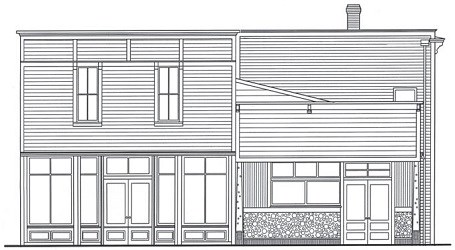Later History
In 1903, John Anderson acquired the former Hotel Rosalie/Brownell's Hardware and began transforming it into a saloon. Charles Walker, designer of the driftwood facade of the Arctic Brotherhood hall, helped Anderson construct a new facade of driftwood, stones, and concrete. The new Pantheon Saloon, complete with bar and slot machines, stayed in business until 1916. Meanwhile, Elwood Moyer bought the former A.C. Fasel paint store and converted it into a general merchandise store. He painted the building red and named it the Red Front store. In 1911, the Moyers sold the building to John Anderson, owner of the Pantheon, who used the building for storage. When Skagway voted to go dry in 1916 (two years before national prohibition), the Pantheon Saloon was forced to close. At some point in the 1920s, the abandoned Red Front was torn down as a fire hazard. The former Pantheon later operated as a museum, a saloon during World War II, a restaurant, a bakery, and a curio shop before it was sold to the National Park Service in 1977.
Historic Restoration
Restoration of historic buildings owned by the National Park Service is guided by the Secretary of the Interior's standards for the treatment of historic properties. There are four preservation treatments: preservation, rehabilitation, restoration, and reconstruction. Preservation maintains a structure's current appearance, making it stable and safe for visitors while maintaining its current form. The Ice House, near the Moore Homestead at 5th and Spring Streets, is a good example of the treatment of preservation. Most National Park Service-owned buildings in Skagway have followed the principles of restoration and rehabilitation. Restoration involves depicting properties at a particular time in their history while removing evidence of other periods. Rehabilitation acknowledges the need to add compatible uses to a historic property to meet changing uses, while maintaining the building's historic character. The Pantheon Saloon is an example of restoration, in that park management chose to restore the exterior of the building to its 1903-1916 appearance as the Pantheon Saloon. It is also an example of rehabilitation, as the building's interior was adapted to house park offices upstairs and modern retail space downstairs. The treatment of reconstruction was applied to the Red Front. Reconstruction recreates vanished elements of a property, in this case rebuilding the entire store based on historical evidence (such as the above photograph). The Red Front's reconstruction serves the park as museum storage upstairs and leased commercial space downstairs.
Historic Building Leasing Program
The Pantheon Saloon and Red Front Building are two of over a dozen historic buildings owned by Klondike Gold Rush National Historical Park. Many of these buildings are leased to private businesses under the provisions of the National Historic Preservation Act. Annual lease payments help offset the costs of maintaining this and other historic buildings in the park. The compatible commercial use of this structure continues Skagway's long tradition as a bustling center of business activity.





